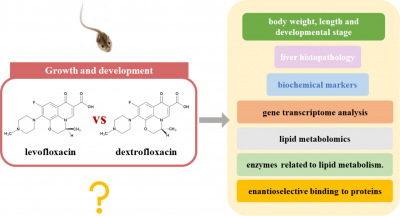Newswise — Researchers from College of Environment, Hohai University, et al. have conducted a study entitled “Stereoselective effects and its potential mechanism of ofloxacin on the growth and development of Rana nigromaculata: mainly liver lipid metabolism”. This study was published in Frontiers of Environmental Science & Engineering, Volume 19, Issue 4.
Most research on antibiotics in the environment disregards chiral antibiotics, such as ofloxacin (OF). In this study, tadpoles of Rana nigromaculata were exposed to 1 μg/L OF and levofloxacin (LVFX, an enantiomer of OF) for 75 d. Compared with dextrofloxacin, LVFX treatment had a greater effect on the inhibition of bodyweight, body length, development stage, and pathological liver damage. Therefore, OF exerts a stereoselective inhibitory effect on both growth and development, which is consistent with the results at the systemic metabolism level. Transcriptomic analysis revealed that the differentially expressed genes between OF and LVFX were mainly immune related. Targeted metabolomics showed that the stereoselective biological effect of OF on R. nigromaculata was caused by differences in contents of PE-O 16:0–22:4, PE 16:0–14:0, TAG 45:0–FA16:0, PE-P 18:0–16:0, PE 16:0–16:0, PC 16:0–22:4 + AcO, PE 18:1–18:3, PC 16:1–18:1 + AcO, and PC 18:1–18:3 + AcO. Furthermore, two enantiomers of OF were selectively bound to enzymes related to lipid metabolism. This study provides both theoretical and practical references for the accurate evaluation and scientific control of the ecological risk of chiral antibiotics.
This study was supported by the National Natural Science Foundation of China and the Fundamental Research Funds for the Central Universities (China). For more detailed information, the full paper is available at: https://journal.hep.com.cn/fese/EN/10.1007/s11783-025-1970-2.
